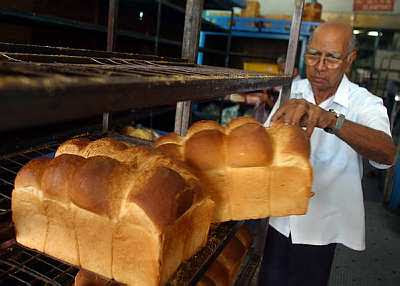This is our very own local
salad, sometimes known as “Indian Rojak”. It is sometimes referred to as “cheh
hoo”, literally translated to “green fish” ie raw fish, because that used to be
one of the constituents. Originally these were two different dishes, but time
and cultures have blended the two, and they are now more or less the same thing.
Whatever name you know it by, up here in Penang, pasembor
is the mixture of sliced-up dough and cucuk udang (prawn fritters), bean curd,
boiled potatoes and hard-boiled egg served atop a bed of roughly-julienned
vegetables, primarily cucumber and bangkwang (yam bean).
It is served with a
dressing that is totally unique to the east – a large, loving ladleful of
thick, rich, sweet, reddish-brown spicy sauce made with Ubi Keledek (sweet
potato) and chillis.
As soon as the
salad is served to you, toss it to ensure the sauce mixes well with all the
layers. It also softens the crispy fritter edges and flavours the vegetables at
the same time. Although slightly sweet for some, the combination of
carbohydrates and vegetables (and grease notwithstanding), is quite tasty and
relatively healthy, as there is plenty of fresh crispy greens.
Like other hawker foods, it’s available everywhere, and
of course practically every hawker centre, along with Mamak stalls and food
courts, many with their own loyal clients who have been eating there regularly
for the past few decades.
Some are so well known that they have been featured in
various food and travel programmes on TV.
Pasembor is a wonderful potpourri of all things Malaysian, and particularly popular as a tea time treat.
NASI KANDAR
Nasi Kandar is a popular northern Malaysian dish, which originates from Penang. It is a meal of steamed rice which can be plain or mildly flavored, and served with a variety of curries and side dishes.
The word Nasi Kandar, came about from a time when nasi [rice] harwkers or vendors would kandar [balance] a shoulder pole with two huge containers of rice meals. The name has remained and today the word Nasi Kandar is seen on most Tamil Muslim or "Malaysian Mamak" restaurants and Indian-Muslim stall meals.
The rice for a nasi kandar dish is often placed in a wooden container about three feet high, giving it a distinctive aroma. The rice is accompanied by side dishes such as fried chicken, curried spleen, cubed beef, fish roe, fried prawns or fried squid. The vegetable dish would usually be brinjal (aubergine), okra (lady fingers or "bendi") or bitter gourd. A mixture of curry sauces is poured on the rice. This is called 'banjir' (flooding) and imparts a diverse taste to the rice.
Traditionally, nasi kandar is always served with its side dishes on a single plate. Nowadays, small melamine bowls are used for the side dishes. Nevertheless, the curry sauce mix is always poured directly onto the rice.
The most famous nasi kandar stalls in Penang are Kassim Restaurant and Line Clear.In Selangor, one chain of nasi kandar restaurants are Restoran Syed and Ahmad Shah Restaurant. Meanwhile in Kedah, the famous nasi kandar restaurants are Nasi Kandar Pokok Ceri and Royale Hijau Kuning. In recent years, several chain restaurants have appeared such as Nasi Kandar Nasmir, Pelita Nasi Kandar and Kayu Nasi Kandar. Purists have disputed its tastiness compared to the original Penang versions. In Perlis, the rice is coloured yellow with herbs and the dish is referred to as "nasi ganja", though in fact no "ganja" (cannabis) is actually used in its preparation
ROTI BENGGALI
Roti Bengali is an old style roti
about three inches wide and six inches long with a dome at the exposed top. I
don't know why it's called Roti Bengali as the proprietor is neither a Bengali
or from Punjab but whatever it is, this roti can rival any french bread
anytime. It has a leathery but soft outer crust but once the bread is sliced,
you can smell the engaging aroma of freshly baked flour. It's white bread is
soft, moist and fresh. Really delicious! I guess that all those years of
experience really shows.





.jpg)
.jpg)
.jpg)
.jpg)
